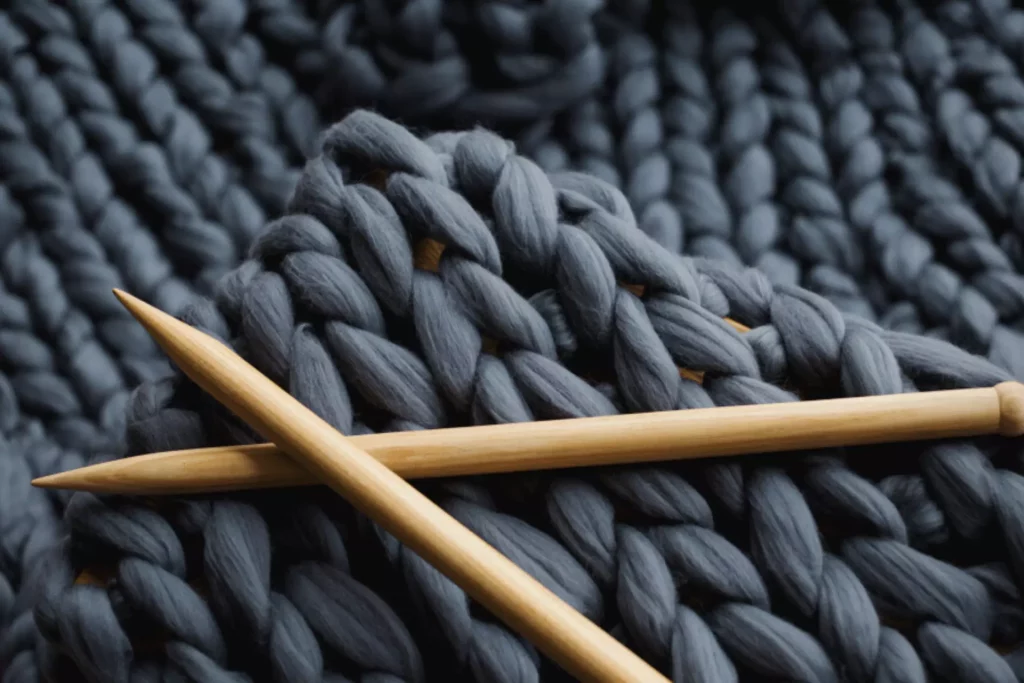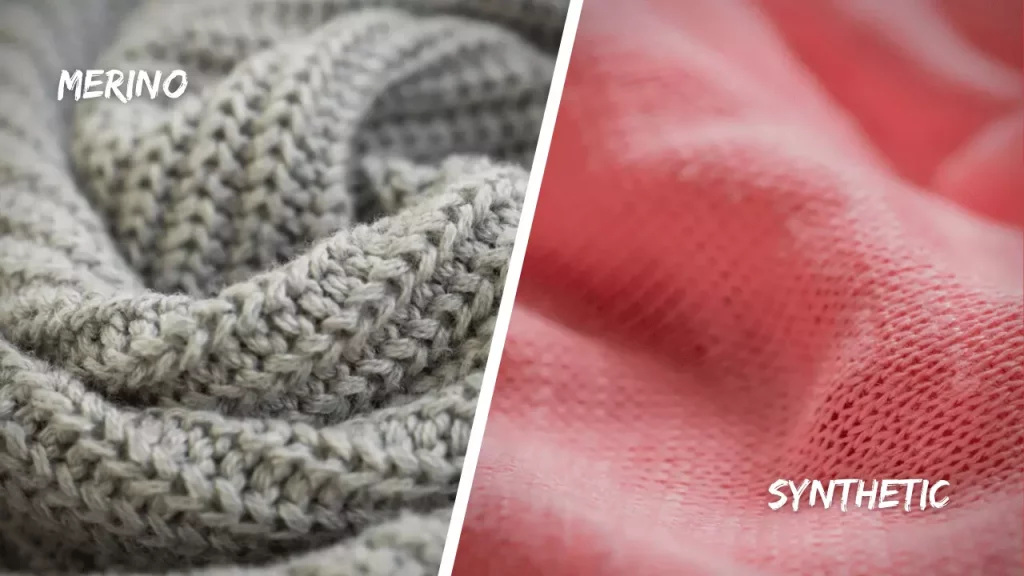Next to skin, the base layer, is the most important part of your clothing, especially when hiking or backpacking. A poor material selection can quickly turn your adventure into the worst experience ever. It is because the unsuitable material sticks to the body due to sweat and results in chafing and rubbing.
However, materials like Merino wool or synthetic base layer can aid your body by trapping the body heat and preventing hypothermia by complete insulation. Therefore, in this article, I will discuss in detail the difference between Merino Wool Vs. Synthetic Wool and which of them is the better option.
Table of Contents
Why Should I Care About Base Layers?
The base layer is of utmost importance in every hiking trip dress-up. It is the first layer of clothing that remains next to your body. The base layer should be comfortable, durable, moisture-wicking, and odor resistant.
Moreover, the clothing should stick close to the body but still allow free and comfortable movement. Otherwise, your hiking trip will become more exhausting and difficult than ever.
Secondly, the choice of synthetic vs. merino wool base layer depends on the climatic conditions and the area that you are visiting. For instance, hot summer weather requires a lightweight, sweat-soaking, and breathable base layer. This ensures that the sweat generated by your body is quickly soaked and doesn’t cause rashes on your body.
Furthermore, the summer base layer should be somewhat insulating to keep you warm during the early morning and nighttime.
Similarly, areas with constantly changing weather conditions and winter hiking require a whole different base layer. The material should be heavy, insulating, thermal trapping, odor resisting, and sweat soaking.
Thus the base layer will keep you warm throughout the trip while preventing skin rash due to sweat. However, you can only use a suitable material like Merino wool or synthetic wool fabric, as other materials like cotton are not moisture soaking.
Merino Wool:

Merino is natural wool mainly produced in Australia and the USA. Its properties are very similar to ordinary natural wool but only better. For instance, merino wool thermals are highly insulating, heat-trapping, and lightweight.
As a result, most premium base layer clothing such as shirts and leggings are made from Merino wool. However, Merino is a costly material, so several manufacturers use a merino wool blend with synthetic fabric to improvise the material’s properties without adding much to the cost.
Best Use of Merino Wool:
Merino wool is perfect for areas with extremely cold conditions and steep climbs. The lightweight of the material allows greater room for movement without tiring your body.
Similarly, it is perfect for trapping the body heat and keeping it stored for long periods. Lastly, it is a sweat-soaking material that doesn’t get wet with sweat very easily. So, sweat freezing is of no concern if you are hiking in a snowy area.
Pros:
- Warmth: Merino wool is an insulating material that efficiently traps the body heat and keeps it stored over long periods. Moreover, you won’t feel the cooling effect even if the layer is wet with sweat.
- Odor-resistant: Sweat odor is the biggest concern for every hiker and adventurer. Fortunately, Merino is an odor-resistant material that dissipates the sweat smell without allowing any buildup of salts. Overall, it takes at least 6-7 runs before you need to wash the clothing.
- Cooling properties: Merino is a multi-climate material that is equally beneficial for both hot and cold climates. The lightweight half sleeve shirts are perfect for the summer months as they take away the sweat and allow airflow to your body.
- Breathability: Merino shirts are perfect for both hot and cold regions. It is because it performs better than most synthetic fibers in wet sweat conditions. The sweat buildup in the shirt fibers doesn’t prevent the airflow to your body and offers perfect breathability.
- Weight: The weight of the fabric is the biggest concern when choosing a base layer. It is because overweight materials are not comfortable to wear and limit body movements. In this regard, Merino is a lightweight material that offers the properties of heavy-duty fiber.
Cons:
- Less Durable: Merino is a natural material with no special durability qualities. The lightweight fibers are not inert to environmental and chemical hazards. Moreover, a single base layer is only useful for 2-3 hiking trips.
- Expensive: Merino wool is hard to manufacture, and the importing cost is also a problem. So, these shirts and leggings are usually pricier than locally manufactured synthetic base clothing.
- Insect attack: Merino wool is among the favorite meals for many insects like moths. You will notice holes in the shirt if you hang it outside as the insects eat away some of the fibers.
Synthetic Wool:

Synthetic fibers refer to a number of artificial materials produced from various polymers. They provide a large range of applications depending on the weather conditions and the type of material. Generally, polyester and nylon are the most commonly used synthetic fiber for base layer clothing.
However, it is less moisture absorbing than Merino and other natural fibers. The good news is that synthetic fiber is easy to manufacture, and its products are relatively cheaper than natural fibers.
Best Use of Synthetics:
Synthetic fiber base layers are generally more durable than Merino. So, they are perfect for those who are looking for a long-lasting material. The major problem with synthetic wool fibers is that they are not odor-resistant and thus require washing more often to the point of no return. Overall, synthetic base layers are more durable, less expensive, and easy to replace after a few hiking trips.
Pros:
- Durable: Synthetic wool is made from polyester and nylon. It is an inert material that offers resistance to both environmental and chemical decomposition. Moreover, insects like moths don’t damage the fiber even if you hang it outside for drying.
- Budget-friendly: Synthetic fiber is easy to manufacture, locally available, and long-lasting. So, the total cost of synthetic Merino wool shirts is relatively less than natural Merino wool shirts. Moreover, you can use them as disposable shirts and replace them without adding much to the budget after every hiking trip.
- Sustainable: Synthetic wool is the perfect substitute for natural wool. It doesn’t require special raising of cattle for the production, and the animals are not hurt in the process. So, synthetic wool is completely environmentally sustainable apart from the land pollution increase due to the production of polymers.
- Breathable: Synthetic wool is a breathable material that allows proper airflow to the body even if the fibers are filled with moisture. So, you won’t experience any rash or moisture discomfort even after several hours of hiking.
Cons:
- Less warm: Synthetic wool is a breathable material; however, it is more weighty than natural wool. Moreover, it offers comparatively less warmth than natural wool due to poor fiber properties. In short, you will experience some weight on the body if you compare it with a Merino fiber shirt.
- Odorous: Synthetic wools like polyester and nylon are poor odor-resistant materials. They allow the sweat salts to build up in the fibers without dissipating the smell. So, you need to rewash the base layer after every hiking trip to remove all the sweat entrapped in its fibers.
Merino Wool vs. Synthetic Wool:

Overall, both Merino and synthetic wools are perfect for the base layer and thermal clothing. Both of the materials offer almost similar properties apart from a few differences. So, if you are looking for the general idea, I recommend any of these materials over cotton or silk clothing.
The Merino wool shirts are relatively lightweight, odor resisting, and you don’t need to wash them as often. However, the major factors like price and durability of the Merino wool fibers give the upper hand to synthetic material.
Similarly, synthetic wool fiber is relatively more durable, less expensive, and offers protection against insect damage. Moreover, some synthetic materials are modified to provide fire resistance and freezing resistance. You can also get some Merino fiber properties in the shirts that have Merino blend in them. However, synthetic fiber shirts are poor odor dissipation and offer significantly lower body heat-trapping than natural wools.
Which Base Layer is Best?

By now, you understand the general concept, the pros, and the cons of both Merino wool and synthetic wool fibers. When comparing the wools, it all depends on your preferences and the climatic conditions of the hiking region.
Overall, Merino fiber is the better option as it provides better sweat dissipation, provides more warmth, and allows optimum breathability for the body. Moreover, Merino wool shirts are multi-climatic and offer equal benefits in both hot and cold regions.
The major disadvantage of Merino wool is that it is prone to insect damage and is relatively expensive. So, if you can’t afford a Merino wool base layer or are hiking in a region with an insect problem, in that case, synthetic wool clothing seems like a better option as it overcomes all the flaws in the Merino wool.
Frequently Asked Questions:
Which material is better when wet, Merino wool VS. Synthetics?
Merino wool offers better moisture management and insulation than synthetic wool fibers. It dissipates the sweat salts and keeps your body insulated from the cooling effect of sweat. So, Merino wool performs better in wet conditions than any synthetic material.
Merino Wool VS. Synthetic: which is warm when wet?
Merino wool is an insulating material that efficiently traps the body heat and keeps it stored for long periods. Moreover, it traps the sweat moisture in its fibers while allowing room for breathability. So, Merino wool is warmer than synthetic in both dry and wet conditions.
What is synthetic felt vs. wool?
Synthetic felt is an artificial material produced from various polymers like polyester and nylon. It is a cheap, lightweight, and durable material mainly used in the production of undergarments and base layer clothing.
On the contrary, natural wool is extracted from cattle and used for various clothing forms. It is a durable material that offers perfect heat-storing, odor dissipating, and breathability properties. However, synthetic felt is comparatively cheaper than natural wool.
Conclusion:
Merino wool and synthetic wool are widely used in producing undergarments and base layer clothing. It keeps your body warm and free from sweat when hiking, jogging, and working out.
However, both the materials offer almost similar properties, so the comparison between Merino wool Vs. Synthetic Wool is a bit complex. Therefore, in this article, I have explained all the major differences between the two materials to help you choose the best one for your requirements.

